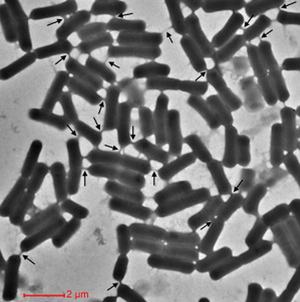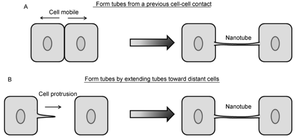Nanotubes facilitate intercellular signaling in eukaryotic and prokaryotic cells: Difference between revisions
No edit summary |
No edit summary |
||
| Line 29: | Line 29: | ||
==HIV Pathogenesis== | ==HIV Pathogenesis== | ||
[[Image:Screen_Shot_2015-04-20_at_10.56.50_AM.png|thumb|300px|right|Figure 3. Detection of HIV-p24 (green staining) and actin (Texas Red-phalloidin, red staining) in macrophages containing DAPI (blue staining) through fluorescent staining. (C | [[Image:Screen_Shot_2015-04-20_at_10.56.50_AM.png|thumb|300px|right|Figure 3. Detection of HIV-p24 (green staining) and actin (Texas Red-phalloidin, red staining) in macrophages containing DAPI (blue staining) through fluorescent staining. (C) Nanotubes found in HIV-infected human macrophages three days post-infection. (D-F) An enlargement of the nanotubes in the white box shown in (C). Panels (D) and (E) were merged to form panel (F), in which nanotubes containing HIV-p24 can be seen. [16]<br> | ||
<http://www.ncbi.nlm.nih.gov/pmc/articles/PMC2701345/figure/F5/>.]] | <http://www.ncbi.nlm.nih.gov/pmc/articles/PMC2701345/figure/F5/>.]] | ||
<br>Include some current research in each topic, with at least one figure showing data.<br> | <br>Include some current research in each topic, with at least one figure showing data.<br> | ||
Revision as of 22:48, 20 April 2015
Overview

<http://www.sciencedirect.com/science?_ob=MiamiCaptionURL&_method=retrieve&_eid=1-s2.0-S009286741100016X&_image=1-s2.0-S009286741100016X-figs5.jpg&_cid=272196&_explode=defaultEXP_LIST&_idxType=defaultREF_WORK_INDEX_TYPE&_alpha=defaultALPHA&_ba=&_rdoc=1&_fmt=FULL&_issn=00928674&_pii=S009286741100016X&md5=b2d22cbeb0a19edbc6d02597fb061a4d>.
At right is a sample image insertion. It works for any image uploaded anywhere to MicrobeWiki. The insertion code consists of:
Double brackets: [[
Filename: PHIL_1181_lores.jpg
Thumbnail status: |thumb|
Pixel size: |300px|
Placement on page: |right|
Legend/credit: Electron micrograph of the Ebola Zaire virus. This was the first photo ever taken of the virus, on 10/13/1976. By Dr. F.A. Murphy, now at U.C. Davis, then at the CDC.
Closed double brackets: ]]
Other examples:
Bold
Italic
Subscript: H2O
Superscript: Fe3+
Structure
Include some current research in each topic, with at least one figure showing data.
Formation

<http://link.springer.com/article/10.1007%2Fs11427-013-4548-3>.
Include some current research in each topic, with at least one figure showing data.
HIV Pathogenesis

<http://www.ncbi.nlm.nih.gov/pmc/articles/PMC2701345/figure/F5/>.
Include some current research in each topic, with at least one figure showing data.
HTLV Pathogenesis
Overall paper length should be 3,000 words, with at least 3 figures.
Prion Pathogenesis

Include some current research in each topic, with at least one figure showing data.
Prion Pathogenesis
Include some current research in each topic, with at least one figure showing data.
Genetic and cytoplasmic exchange in B. subtilis
Include some current research in each topic, with at least one figure showing data.
Metabolic mutualism between E. coli and Acinetobacter baylyi
Include some current research in each topic, with at least one figure showing data.
References
Edited by student of Joan Slonczewski for BIOL 238 Microbiology, 2009, Kenyon College.
